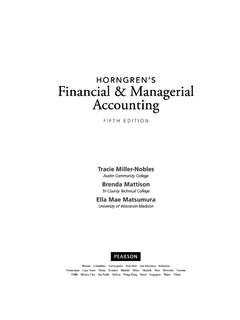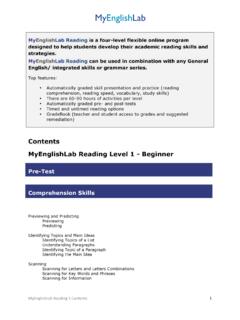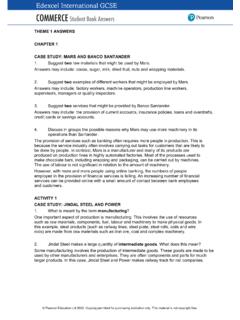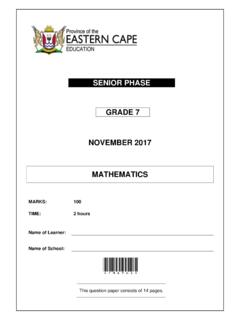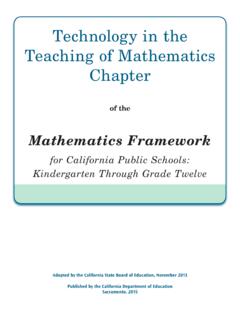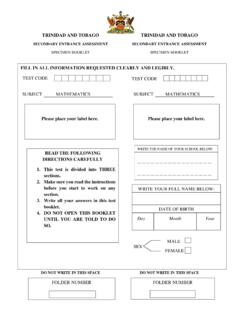Transcription of Mathematics of Finance - Pearson
1 198 Mathematics of Simple and Compound Future Value of an Present Value of an Annuity; Amortization Chapter 5 Review Extended Application: Time, Money, and PolynomialsBuying a car usually requires both some savings for a down payment and a loan for the balance. An exercise in Section 2 calculates the regular deposits that would be needed to save up the full purchase price, and other exer-cises and examples in this chapter compute the payments required to amortize a 19819/03/15 11:58 AMCopyright Pearson . All rights for Simple and Compound Interest199 Everybody uses money. Sometimes you work for your money and other times your money works for you. For example, unless you are attending college on a full scholarship, it is very likely that you and your family have either saved money or borrowed money, or both, to pay for your education.
2 When we borrow money, we normally have to pay interest for that privilege. When we save money, for a future purchase or retirement, we are lending money to a financial institution and we expect to earn interest on our investment. We will develop the Mathematics in this chapter to understand better the principles of borrowing and saving. These ideas will then be used to compare different financial opportunities and make informed Tip: Chapter 5 is full of symbols and formulas. Students will need to become familiar with the notation and know which formula is appropriate for a given problem. Section ends with a summary of and Compound InterestIf you can borrow money at 8% interest compounded annually or at compounded monthly, which loan would cost less?
3 In this section we will learn how to compare different interest rates with different com-pounding periods. The question above will be answered in Example ItSimple InterestI PrtwhereP is the principal;r is the annual interest rate (expressed as a decimal);t is the time in years. Simple InterestTo buy furniture for a new apartment, Pamela Shipley borrowed $5000 at 8% simple interest for 11 months. How much interest will she pay?Solution Since 8% is the yearly interest rate, we need to know the time of the loan in years. We can convert 11 months into years by dividing 11 months by 12 (the number of months per year). Use the formula I=Prt, with P=5000, r= , and t=11/12 (in years).
4 The total interest she will pay isI= ,or $ 1 Simple Interest Interest on loans of a year or less is frequently calculated as simple interest, a type of interest that is charged (or paid) only on the amount borrowed (or invested) and not on past interest. The amount borrowed is called the principal. The rate of interest is given as a percentage per year, expressed as a decimal. For example, 6%= and 11 12%= The time the money is earning interest is calculated in years. One year s interest is calculated by multiplying the principal times the interest rate, or Pr. If the time that the money earns interest is other than one year, we multiply the interest for one year by the number of years, or 19919/03/15 11:58 AMCopyright Pearson .
5 All rights for SaleChAPTER 5 Mathematics of Finance 200A deposit of P dollars today at a rate of interest r for t years produces interest of I=Prt. The interest, added to the original principal P, givesP+Prt=P11+ amount is called the future value of P dollars at an interest rate r for time t in years. When loans are involved, the future value is often called the maturity value of the loan. This idea is summarized as or Maturity Value for Simple InterestThe future or maturity value A of P dollars at a simple interest rate r for t years isA P11 rt2. maturity ValuesFind the maturity value for each loan at simple interest.(a) A loan of $2500 to be repaid in 8 months with interest of The loan is for 8 months, or 8/12=2/3 of a year.
6 The maturity value is A=P11+rt2 =2500c1+ d P 2500, r , t 2/3 250011+ ,or $ (The answer is rounded to the nearest cent, as is customary in financial problems.) Of this maturity value,I=A-P=$ $2500=$ interest.(b) A loan of $11,280 for 85 days at 7% interestSolution It is common to assume 360 days in a year when working with simple interest. We shall usually make such an assumption in this book. Using P=11,280, r= , and t=85/360, the maturity value in this example isA=11,280c1+ d 11, ,or $11, TRY YOUR TURN 1 ExamplE 2 YOUR TURN 1 Find the matu-rity value for a $3000 loan at interest for 100 days. When using the formula for future value, as well as all other formulas in this chapter, we often neglect the fact that in real life, money amounts are rounded to the nearest penny.
7 As a consequence, when the amounts are rounded, their values may differ by a few cents from the amounts given by these formulas. For instance, in Example 2(a), the interest in each monthly payment would be $ $ , rounded to the nearest penny. After 8 months, the total is 81$ $ , which is 1 more than we computed in the part (b) of Example 2 we assumed 360 days in a year. Historically, to simplify calcu-lations, it was often assumed that each year had twelve 30-day months, making a year 360 days long. Treasury bills sold by the government assume a 360-day year in calculating interest. Interest found using a 360-day year is called ordinary interest, and interest found using a 365-day year is called exact 20019/03/15 11:58 AMCopyright Pearson .
8 All rights for Simple and Compound Interest201 The formula for future value has four variables, P, r, t, and A. We can use the formula to find any of the quantities that these variables represent, as illustrated in the next example. Simple Interest RateAlicia Rinke wants to borrow $8000 from Robyn Martin. She is willing to pay back $8180 in 6 months. What interest rate will she pay?Solution Use the formula for future value, with A=8180, P=8000, t=6/12= , and solve for r. A=P11+rt2 8180=800011+ 8180=8000+4000r Distributive property 180=4000r Subtract 8000. r= Divide by , the interest rate is (written as a percent). TRY YOUR TURN 2 ExamplE 3 YOUR TURN 2 Find the inter-est rate if $5000 is borrowed, and $ is paid back 9 months you deposit money in the bank and earn interest, it is as if the bank borrowed the money from you.
9 Reversing the scenario in Example 3, if you put $8000 in a bank account that pays simple interest at a rate of annually, you will have accumulated $8180 after 6 Interest As mentioned earlier, simple interest is normally used for loans or investments of a year or less. For longer periods compound interest is used. With compound interest, interest is charged (or paid) on interest as well as on principal. For example, if $1000 is deposited at 5% interest for 1 year, at the end of the year the interest is $ $50. The balance in the account is $1000+$50=$1050. If this amount is left at 5% interest for another year, the interest is calculated on $1050 instead of the original $1000, so the amount in the account at the end of the second year is $1050+$ $ Note that simple interest would produce a total amount of only$1000 31+ $ additional $ is the interest on $50 at 5% for one find a formula for compound interest, first suppose that P dollars is deposited at a rate of interest r per year.
10 The amount on deposit at the end of the first year is found by the simple interest formula, with t= +r#12=P11+r2If the deposit earns compound interest, the interest earned during the second year is paid on the total amount on deposit at the end of the first year. Using the formula A=P11+rt2 again, with P replaced by P11+r2 and t=1, gives the total amount on deposit at the end of the second +r2411+r#12=P11+r22In the same way, the total amount on deposit at the end of the third year isP11+ , if P is the initial deposit, in t years the total amount on deposit isA=P11+r2t,called the compound 20119/03/15 11:58 AMCopyright Pearson . All rights for SaleChAPTER 5 Mathematics of Finance 202 Interest can be compounded more than once per year.

